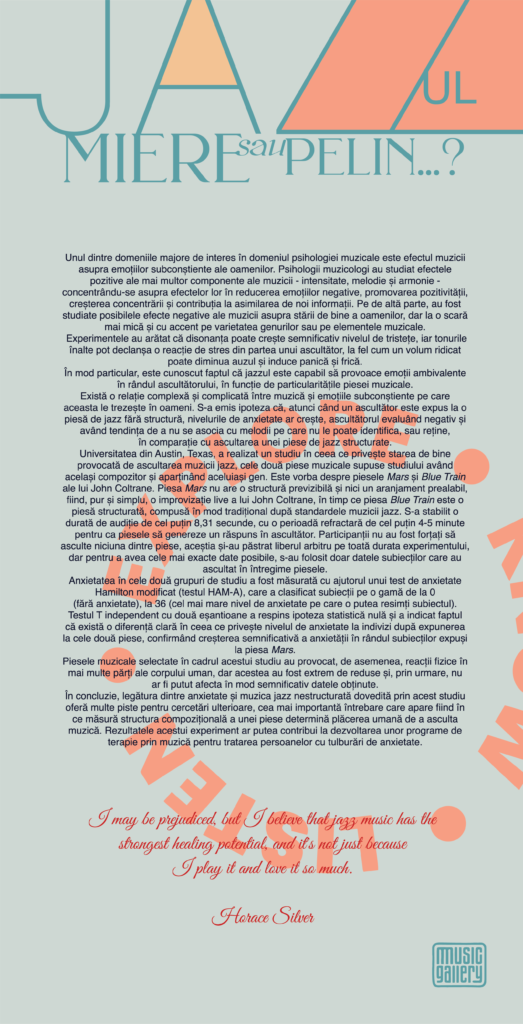JAZZ – HONEY OR WORMWOOD…

(P48) JAZZ – HONEY OR WORMWOOD
One of the major areas of interest in the field of music psychology is the effect of music on people’s subconscious emotions. Music psychologists have studied the positive effects of several components of music – intensity, melody, and harmony – focusing on their effects in reducing negative emotions, promoting positivity, increasing concentration, and contributing to the assimilation of new information. On the other hand, possible negative effects of music on people’s well-being have been studied, but on a smaller scale and with a focus on genre variety or musical elements.
Experiments have shown that dissonance can significantly increase the level of sadness, and high-pitched tones can trigger a stress response in a listener, just as loud volume can reduce hearing and induce panic and fear.
In particular, it is known that jazz is capable of provoking ambivalent emotions in the listener, depending on the peculiarities of the musical piece. There is a complex and complicated relationship between music and the subconscious emotions it arouses in people. The hypothesis has been put forward that when a listener is exposed to an unstructured jazz piece, anxiety levels may increase, the listener evaluating it negatively and tending not to associate with melodies that they cannot identify or remember, compared to listening to a structured jazz piece.
The University of Austin, Texas, conducted a study on the well-being caused by listening to jazz music, with the two musical pieces studied having the same composer and belonging to the same genre. These are John Coltrane’s pieces, “Mars” and “Blue Train.” The “Mars” piece has no predictable structure or pre-arrangement, simply being a live improvisation by John Coltrane, while “Blue Train” is a structured piece, composed traditionally according to jazz music standards. An audition duration of at least 8.31 seconds was established, with a refractory period of at least 4-5 minutes for the pieces to generate a response in the listener. Participants were not forced to listen to either piece, they maintained their free will throughout the experiment, but to have the most accurate data possible, only data from subjects who listened to the entire piece were used.
Anxiety in the two study groups was measured using a modified Hamilton Anxiety Test (HAM-A), which classified subjects on a scale from 0 (no anxiety) to 36 (the highest level of anxiety a subject could feel). The two-sample independent T-test rejected the null statistical hypothesis and indicated that there is a clear difference in individuals’ anxiety levels after exposure to the two pieces, confirming a significant increase in anxiety among subjects exposed to the “Mars” piece.
The musical pieces selected in this study also caused physical reactions in several parts of the human body, but these were extremely small and therefore could not significantly affect the data obtained.
In conclusion, the link between anxiety and unstructured jazz music demonstrated by this study provides many avenues for further research, with the most important question being to what extent the compositional structure of a jazz piece affects the listener’s emotions. The results of this experiment could contribute to the development of music therapy programs for treating individuals with anxiety disorders.
I may be prejudiced, but I believe that jazz music has the strongest healing potential, and it’s not just because I play it and love it so much. – Horace Silver